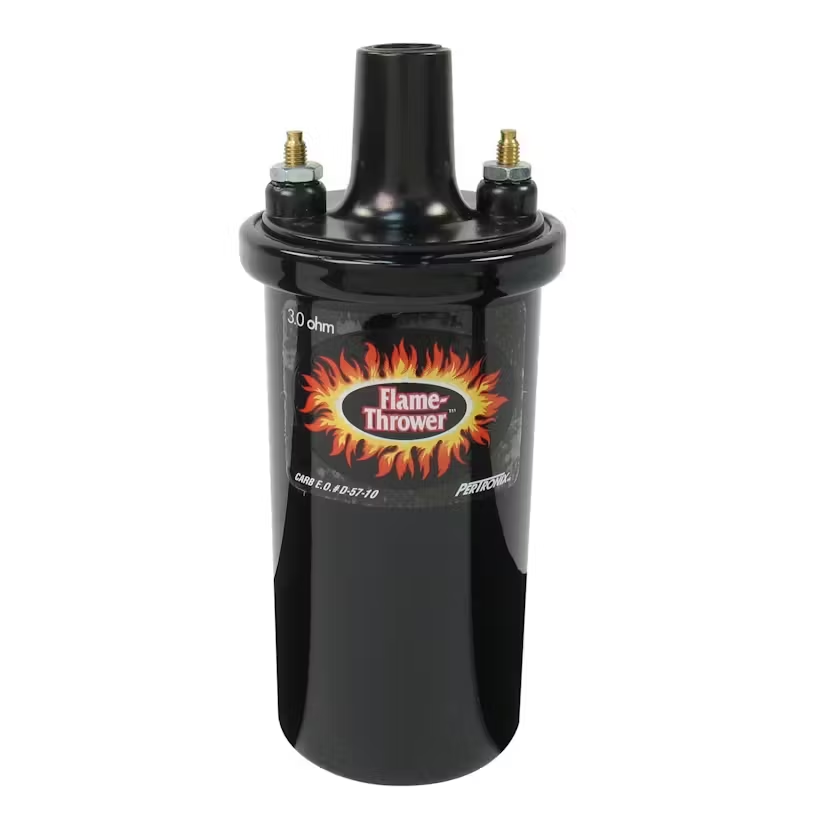Fact --- The Pertronix coil catalog says to use a 3.0 coil for ALL six cylinder cars. This is just silly as different six cylinder cars use different coils. The Corvair coil primary is about 1.3 ohms and the ballast is about 1.8 ohms.
I did the research through the Pertronix documentation to try to understand why Pertronix recommends the use of their 3.0 ohm coil in 4 and 6 cylinder engines, while recommending their 1.5 ohm coil as designed to be optimized for an 8-cylinderengine installation.
The original Corvair primary wiring harness is designed to divide the total optimal Primary resistance design of nominally 3.0 ohms into two parts:
IGNITION BALLAST RESISTOR WIRE: 1.8 OHMS
DELCO-REMY IGNITION COIL PRIMARY RESISTANCE: 1.28 - 1.42 OHMS
TOTAL SERIAL PRIMARY RESISTANCE: 3.08 OHMS (1.8 + 1.28) to 3.22 OHMS (1.8 + 1.28).
This division of the needed 3.0 ohm Primary resistance into two separate parts permits a design that includes integrated switching to the nominal 3 ohm total for normal engine operation, while permitting the starter solenoid switching to electrically take the ballast resistor wire out of the circuit to provide a "hotter" spark for cold engine startup. The starter solenoid, when engaged to crank the engine, bypasses the external ballast resistor wire and feeds full 12.5 VDC battery voltage directly to the Delco (1.28 -1.42 ohm) ignition coil. This switching action temporarily boosts the coil output while cranking the engine to promote cold engine startup. THE MOMENT THE ENGINE STARTS THE STARTER IS DISENGAGED, WHICH ELECTRICALLY RECONNECTS THE EXTERNAL BALLAST RESISTOR WIRE TO THE COIL INPUT. This results in the voltage fed to the coil positive terminal dropping from 12.5 VDC to approximately 7 VDC, due to the additional resistance provided by the external ballast resistor. Wit lower input voltage, the coil output to the spark plugs is reduced, but remains high enough to keep the engine running.
The Delco Remy coil is designed to supply adequate spark plug output voltage based on only a nominal 7 VDC input. This lower operating voltage keeps the internal coil temperature down,
while achieving the desired engineering goal of prolonging the life span of the ignition points.
The installation of a Pertronix Ignitor ignition module inside the distributor eliminates the points and substitutes a solid state switching transistor circuit, so the original need to lower the operating voltage across the ignition points switching contacts has become obsolete. In fact, the Pertronix Ignitor design REQUIRES a full 12 VDC source to power the ignition control module. The original Delco coil was engineered to run on an expected 7 VDC (with a ballast resistor wire), so if a breakerless Pertronix ignition module is installed to replace the ignition points, but the Delco coil is retained, the Corvair ends up with a split system that needs to be rewired to bypass the ballast resistor wire to provide adequate power to the Pertronix Ignitor module, while leaving the ballast resistor wire in the circuit to power the Delco coil with only 7 VDC.
Pertronix (of course) recommends upgrading the coil to provide a more-powerful spark to the spark plugs all the time. For a typical 4 or 6-cylinder engine, they recommend their 3 ohm 40,000 Volt Flame Thrower coil. Their 3 ohm coil has been optimized to run with no external ballast resistor and a full 12 VDC power source (like the Pertronix Ignitor module). Optimizing the Pertronix Ignitor 3.0 ohm coil for 12 VDC and an installation on a 4 or 6 cylinder engine Keeps the internal coil temperature down with an internal design structure designed for optimum operation in conjunction with a non-V8 engine. For a V8 engine install, with its increased number of cylinders, has different coil needs. The 1.5 ohm coil is internally designed to be optimized for use with a V8 engine. Using the recommended Pertronix coil permits removal of the ballast resistor wire completely from the circuit, and simplifies the restructure of the ignition wiring in the vehicle.
Understanding the reasons for the original Corvair ignition wiring design allows the installer to properly install the Pertronix Ignitor module wiile retaining the original Delco coil. (This requires 12 VDC full time for the Ignitor module, while retaining the ballast resistor wire circuitry for the Delco coil). If the coil is to be upgraded to a Pertronix Flame Thrower 40,000 volt coil, the 3.0 ohm coil should be selected. This simplifies the wiring, and permits the bypass or removal of the ballast resistor wire completely.
These options are obviously often a point of confusion, and the incorrect choices of aftermarket components, or the incorrect installation and wiring modifications can lead to faulty operation. Pertronix engineers have tried to improve their written installation instructions and also their marketing catalog and documentation. but errors continue to be made.
The design flaw in the Pertronix Ignitor II module, which begins to fail at very slow idle speeds (as in a 6-cylinder Corvair with a Powerglide automatic transmission that slows the idle speed) adds to the confusion.
No, I don't work for Pertronix. I have a Powerglide-based Corvair using a Pertronix Ignitor (not Ignitor II), and that configuration, along with a 3 ohm performance coil and no ballast resistor wire works just fine! I chose a FAST XR-3000 ignition system for my Corsa convertible, just to give that brand and configuration a try too.
I hope this technical information and attempt at an explanation is helpful.



 1966 Corvair Corsa Convertible
1966 Corvair Corsa Convertible